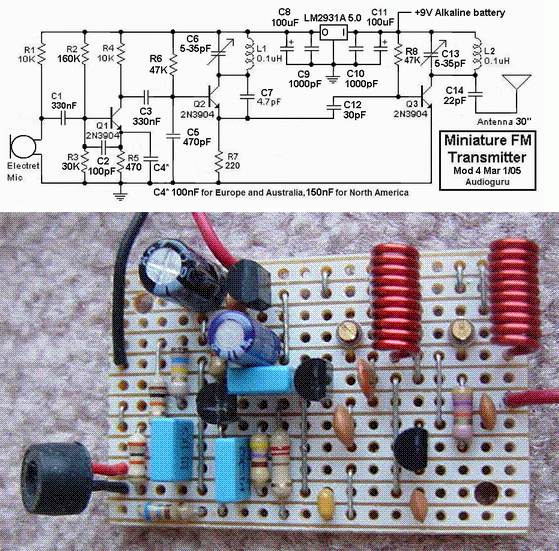I gave you a link to my site some time ago and you are all so jealous, that you banned me from the forum.
Here is an FM transmitter that looks to be well-designed. Apart from the complex circuit, there are a number of fundamentally incorrect features that make the circuit unreliable.
And the layout is one of the worst I have seen for an FM transmitter.
This type of circuit should NEVER be laid out on strip-board and any type of board that has extra conductive lines as they create "wires" that radiate signal and they can be so effective that all the signal is radiated and none is retained to keep the oscillator in a state of oscillation. That's why this type of layout can result in non-operation.
The first item we will look at is the "Q" of the tank circuit.
This is a factor known as "Quality" and comes from the fact that an inductor will produce a voltage (of opposite polarity) that can be about equal to the voltage applied to it.
And that's what a circuit like this FM transmitter does. The voltage produced by the capacitor and parallel inductor on the collector, will produce a voltage about double the 5v on the rail.
These two components are called a TANK CIRCUIT and to get them to produce a high voltage, the energy stored (and released) by the capacitor must be equal to that of the inductor. The two work like tipping water from one jug to another of the same size and back again. If one jug is smaller, we only get the energy from the smaller jug.
In this case the 5-35p air trimmer will be set at about 20p for 90MHz while the energy stored in the 10 turn coil will be twice that needed. The 10 turn coil should be reduced to 5 turns and the capacitor should be increased to 39p - 47p. This will give the circuit a higher "Q."
With a low Q, the energy through C7 (4p7) will be very small.
We don't know how or where the tracks are cut on the "strip-board" but you can see some of the tracks will connect to the end of the 4p7 that goes to the emitter.
This track acts like a "transmission line" and since it is very wide, it will have a high value of radiation.
This means a certain amount of the energy delivered by the 4p7 will be lost to the surroundings and any handling of the project will cause drifting or it could come to a point where the oscillator fails when handled.
In addition, some of the energy delivered by the 4p7 is being lost via the 30p coupling capacitor and the circuit may fail to work. We found 10p is needed.
The circuit may be successful as the oscillator transistor is being heavily driven via the 220R in the emitter. This may overcome the short-falls in the other design-concepts, but the 30p "take-off" should be connected to the collector of the oscillator stage as it will transfer a lot more energy.
High frequency circuits like this need to be designed so the power rails are "tight." This not only means electrical and electronic "tightness" but also physical tightness.
The 1n across the power rails for the oscillator is insufficient to give good tightness (it should be 22n) and the placement of the components on the board is far too spread-out.
This makes the project very susceptible to handling and drifting.
Since the output transistor is a buffer, the 22p on the antenna is not needed and simply reduces the range.
The 10k resistor for the electret mic is too low for our high-sensitivity microphones. It should be 47k for 5v rail.
The 100u electrolytic across the battery is totally unnecessary as the current consumption is only a few milliamp. In addition, the 100u on the output of the regulator needs to be only 1u to 10u.
Overall, I consider the circuit is taking 2 - 3 times more current than it needs.
Our 9v Voyager circuit consumes 7-10mA for 800metre range. This circuit will consumes more than 25mA.
One final point. The air trimmer should be in parallel with a capacitor (39p) so the trimmer is only adjusting a small amount of the total capacitance. This makes it easier to tune across the band and set the frequency.




